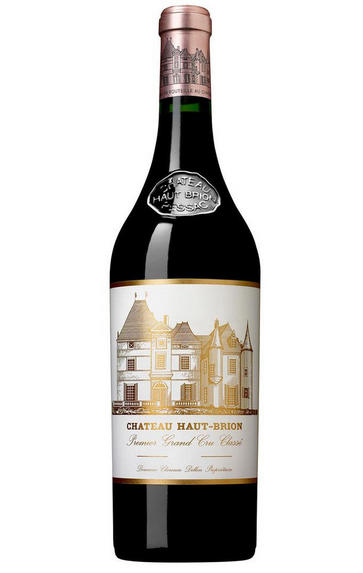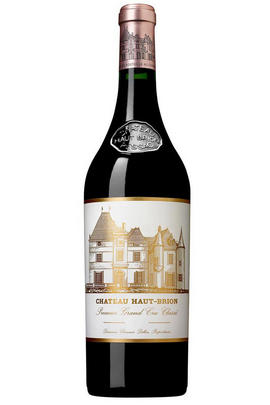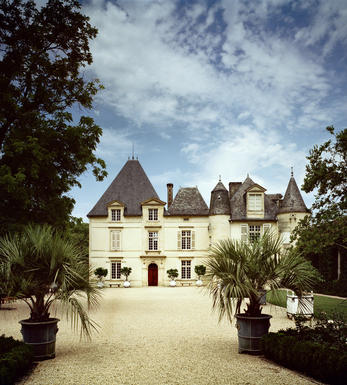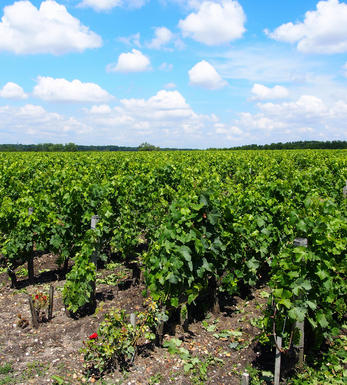
2022 Château Haut-Brion, Pessac-Léognan, Bordeaux

Critics reviews
The 2022 Haut-Brion, matured in 70% new oak, represents the 99th vintage under three generations of the Delmas family (see my recently published book for a remarkable photo of the first). It has slightly darker fruit than the La Mission at the moment. Incense and potpourri infuse the black plum and bilberry.
There's a touch of brine in the background. It manifests more and more complexity as it opens in the glass. The palate is medium-bodied and is blessed with unerring symmetry. It has a bewitching granular texture, complex and more focused than recent vintages, and is almost pixelated on the finish. Quintessential Haut-Brion.
Magnificent but not necessarily the best wine that Delmas oversaw in this vintage.
Drink 2030 - 2065
Neal Martin, Vinous.com (April 2023)
The 2022 Haut-Brion is a bit restrained, given the natural opulence of the year and the other wines in the Clarence Dillon portfolio. Deep and wonderfully layered, the 2022 possesses remarkable depth but also less of the explosive energy of such a Haut-Brion signature.
I suspect that will come in time, as the 2022 shows quite a bit better with a little aeration. Violet, gravel, incense, leather, tobacco and scorched earth linger. Superb.
Drink 2025 - 2062
Antonio Galloni, Vinous.com (April 2023)
Stately, inky colour, this is impressively vivid and energetic despite the intensity of the construction. Fresh fig character, black chocolate, cinnamon, turmeric, creamy bilberry and blackberry fruits, with clove and sandalwood spice, and a slow build of texture and contrast from the slate tannins as they draw out the flavours. Harvest August 29-September 19. 3.9ph. Less Cabernet Sauvignon than usual due to tiny yields,
Drink 2030 - 2050
Jane Anson, JaneAnson.com (May 2023)
The 2022 Haut-Brion shows considerable promise, revealing aromas of dark berries and plums mingled with notions of pencil lead, liquorice, tobacco leaf, spices and incense. It's rich and muscular, full-bodied, broad and seamless, with a deep, layered core of fruit framed by an ample endowment of tannin.
This blend of 53.6% Merlot, 35.4% Cabernet Sauvignon and 11% Cabernet Franc results in a lip-smacking exemplification of controlled power. Analytically, the 2022 possesses a similar level of tannins to the 2010, and a similar pH to the 2009, yet it is more suave and polished than the 2010 at the same stage and seemingly more dynamic than the 2009.
Yohan Castaing, Wine Advocate (April 2023)
53.6% Merlot, 35.4% Cabernet Sauvignon, 11% Cabernet Franc. Cask sample.
Hallmark Haut-Brion opulence of texture. Powerful tannic frame behind. Lovely depth of fruit. Dark- and red-fruit notes with a touch of liquorice as it opens. Complex, powerful and persistent with enough freshness to provide balance.
Drink 2034 - 2055
James Lawther MW, JancisRobinson.com (April 2023)
Currants and cedar with sandalwood and peaches. Fascinating aromas. Violets. Full-bodied with a crunchy and electric palate of primary fruit, with hints of tangerines and citrus. Great finish with structure and polish. 53.6% merlot, 35.4% cabernet sauvignon and 11% cabernet franc. Interesting to have such high merlot in the blend.
James Suckling, JamesSuckling.com (April 2023)
Milk chocolate and blackcurrants on the nose, fragrant ripe black cherries and some floral notes. Sleek, supple, suave, really confident and shiny. This keeps the tension more than La Mission at this point with a vein of freshness and intensity. It’s not out to charm, but it’s out to impress.
Excellent construction, clean depth and power, tense, strict and streamlined, with a touch of creaminess and saltiness. You get waves of flavour intensity with ripe, concentrated fruit, soft acidity and a clean stone freshness. Tannins fill the mouth with edges of both minerality and toasted spices. Calm and controlled, impressive with focus. 3.8pH. A yield of 35hl/ha.
Drink 2030 - 2052
Georgina Hindle, Decanter.com (April 2023)
Slightly better than its sibling La Mission Haut-Brion, the 2022 Château Haut-Brion has a full-bodied, concentrated, structured style that will demand bottle age. Cassis, graphite, scorched earth, and tobacco are just some of its nuances aromatically, and it shows the ripe, powerful style of the vintage. There are lots of tannins here, especially on the finish, and it will need 7-8 years in the cellar.
Jeb Dunnuck, JebDunnuck.com (May 2023)
About this WINE

Chateau Haut-Brion
The only property from outside the Médoc to be included in the 1855 Classification, Haut-Brion’s viticultural history can be traced back further than its Médoc First Growth counterparts. Samuel Pepys even mentions it in his diaries. Situated in what is now Pessac-Léognan, the property finds itself now in the suburbs of the ever-encroaching city of Bordeaux.
After falling into a state of disrepair the estate was purchased in 1935 by Clarence Dillon, an American financier, since when it has enjoyed a steady and continual resurgence to a position of pre-eminence. Dillon’s great-grandson, Prince Robert of Luxembourg, now runs the estate, but a key influence in the reputation which Haut-Brion enjoys today is the Delmas family. George Delmas was manager and wine-maker until 1960, when his son Jean-Bernard took over. Jean- Bernard was a visionary figure, responsible for a number of important innovations, and on his retirement in 2003 his son Jean-Philippe took over as Directeur Générale.
The vineyard is planted to 40% Cabernet Sauvignon, 37% Merlot and 18% Cabernet Franc. A stunning white wine is also made, from a part of the vineyard which is 63% Semillon and 37% Sauvignon Blanc. Production is smaller than at the other First Growth Wines, totalling about 20,000 cases, shared between the Grand Vin and a second wine, formerly called Bahans-Haut-Brion but changed in 2007 to Clarence de Haut-Brion in recognition of Clarence Dillon. Production of Haut Brion Blanc is minute, less than 800 cases in most years.
Beginning with the 2009 vintage a new white wine was introduced in the place of Clarence: La Clarté de Haut-Brion, the offspring of Domaine Clarence Dillon's two prestigious white wines: Château Haut-Brion Blanc and Château La Mission Haut-Brion Blanc.
Fermentation of the red wines takes place in stainless steel vats, after which the wine will spend 22 months, sometimes more, in new oak barrels before being bottled unfiltered. For the white wine fermentation takes place in new oak barrels, after which the wine spends a further year to 15 months on its lees in barrel before bottling. The white wine is truly sensational, equivalent in class to a top-flight White Burgundy Grand Cru, but its scarcity means that it is rarely seen.
The red wine is no less extraordinary; at its best it displays text-book Graves characteristics of cigar-box, curranty fruit, earth, smoky spice and cassis. The high Merlot content, compared to the Médoc First Growths, gives it a voluptuous edge, but does not in any way detract from its ability to age.

Pessac-Leognan
In 1986 a new communal district was created within Graves, in Bordeaux, based on the districts of Pessac and Léognan, the first of which lies within the suburbs of the city. Essentially this came about through pressure from Pessac-Léognan vignerons, who wished to disassociate themselves from growers with predominately sandy soils further south in Graves.
Pessac-Léognan has the best soils of the region, very similar to those of the Médoc, although the depth of gravel is more variable, and contains all the classed growths of the region. Some of its great names, including Ch. Haut-Brion, even sit serenely and resolutely in Bordeaux's southern urban sprawl.
The climate is milder than to the north of the city and the harvest can occur up to two weeks earlier. This gives the best wines a heady, rich and almost savoury character, laced with notes of tobacco, spice and leather. Further south, the soil is sandier with more clay, and the wines are lighter, fruity and suitable for earlier drinking.
Recommended Châteaux: Ch. Haut-Brion, Ch. la Mission Haut-Brion, Ch. Pape Clément, Ch Haut-Bailly, Domaine de Chevalier, Ch. Larrivet-Haut-Brion, Ch. Carmes Haut-Brion, Ch. La Garde, Villa Bel-Air.

Cabernet Sauvignon Blend
Cabernet Sauvignon lends itself particularly well in blends with Merlot. This is actually the archetypal Bordeaux blend, though in different proportions in the sub-regions and sometimes topped up with Cabernet Franc, Malbec, and Petit Verdot.
In the Médoc and Graves the percentage of Cabernet Sauvignon in the blend can range from 95% (Mouton-Rothschild) to as low as 40%. It is particularly suited to the dry, warm, free- draining, gravel-rich soils and is responsible for the redolent cassis characteristics as well as the depth of colour, tannic structure and pronounced acidity of Médoc wines. However 100% Cabernet Sauvignon wines can be slightly hollow-tasting in the middle palate and Merlot with its generous, fleshy fruit flavours acts as a perfect foil by filling in this cavity.
In St-Emilion and Pomerol, the blends are Merlot dominated as Cabernet Sauvignon can struggle to ripen there - when it is included, it adds structure and body to the wine. Sassicaia is the most famous Bordeaux blend in Italy and has spawned many imitations, whereby the blend is now firmly established in the New World and particularly in California and Australia.


Buying options
Add to wishlist
Description
Jean-Philippe Delmas summarised 2022 as a synthesis of 2008’s acidity, 2009’s high pH and 2010’s tannins. The tannins are enormous, dominating the palate and compressing the aromatics. But they are totally admirable, too: restrained and taut despite their size. And Haut-Brion’s classic notes of tobacco, warm earth, sous-bois and wood smoke, and primary blue fruits are detectable.
There is a little more Merlot this year as the Cabernet Sauvignon yield was so small; oddly, the tannins are so marked. This is still very fine, and although brooding and secretive at present, it will make a very good bottle in time.
Merlot 54%; Cabernet Sauvignon 35%; Cabernet Franc 11%
Drink 2032 - 2065
Score: 19/20
Berry Bros. & Rudd (April 2023)
wine at a glance
Delivery and quality guarantee